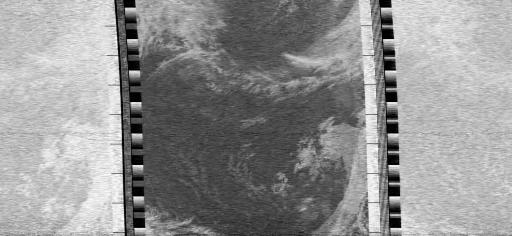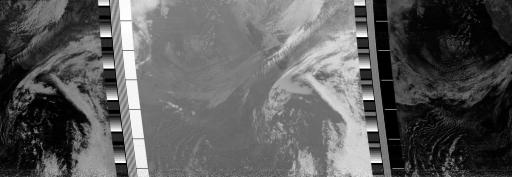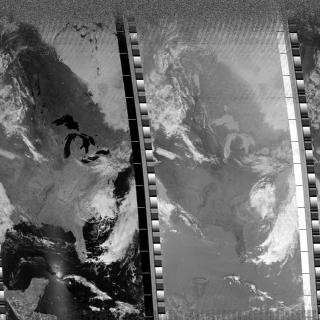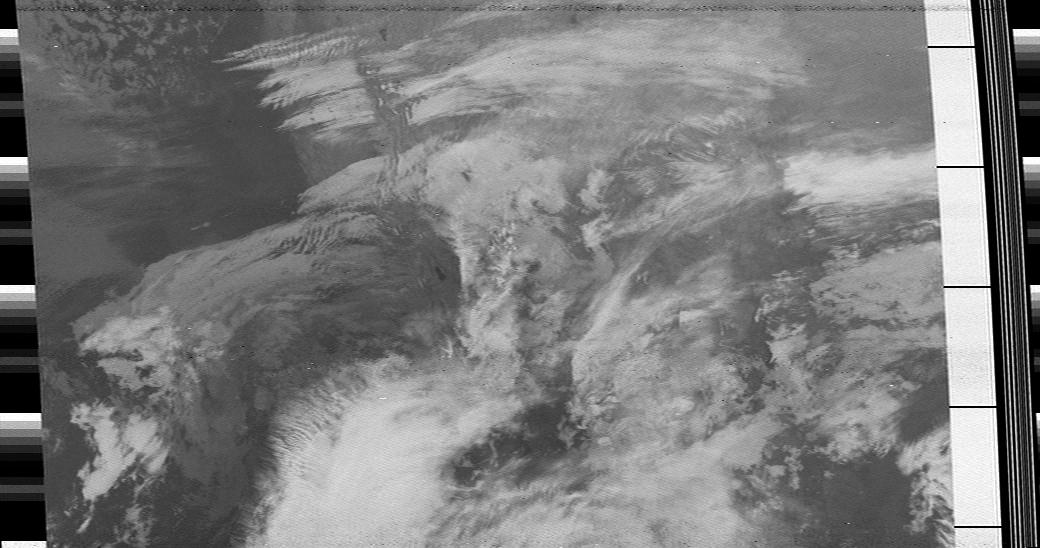I haven’t had the time to record some of the NOAA17 passes during the day, but once night falls, I’ve managed to record a few passes. Tonight, I decided not to use my Yaesu VX-3R, but instead tried to record the pass from my old Radio Shack PRO60 scanner. While I recorded a bit less of the pass than last night, the overall quality seemed really pretty good.
Monthly Archives: November 2007
I <3 Kitties
Lest you all think I’m merely a robotic automata without any sense of sentimentality or soul, I present the following. Thanks Alex for the link.
Night NOAA17 pass…
Best Satellite DX so far…
I was monitoring a routine pass of AO-51 this morning, just listening to some rag chewing, not really diving in myself, until we heard XF4YW calling. One of the regulars identified him as a rare DX, so we all tried to work him from DK48. I had no idea where DK48 was, or that XF4YW would be rare, but it turns out that Eduardo was operating AO-51 as part of a DX expedition to the Mexican island of Socorro. I don’t think he got my call correctly, but still, it was pretty neat. The expedition runs until the 15th of December, so I’ll be listening for him to make sure I work him again.
Here’s the mp3 of the pass. He shows up in the second half of the pass.
Addendum: You can read up about Socorro Island on Wikipedia. It’s area is only 132 square kilometers.
David Taylor’s Weather Satellites
Lots and lots of good information, rather Euro-centric (they seem to have lots more fun with satellites than we do here in the states) but I’m impressed by the depth and breadth of the information contained therein. Found it while searching for information about a helical cavity filter.
Addendum: You can read about the island on Wikipedia.
More weather satellite passes…
Well, I’ve been experimenting a bit more with some weather satellite reception, and on the off chance that anyone cares, I thought I’d write down some of what I learned. Last night (after dark) I decided to record an NOAA-17 pass. This time, I used my Yaesu VX-3R, which has a wideband FM setting, and my totally inappropriate Arrow Yagi that I have been using for satellite reception. I recorded the pass using a little Sony voice recorder. This was my result:

Bigger version, recorded with the Sony Voice Recorder…
It was during the dark, so I didn’t really expect to see much detail, but I noticed lots and lots of horizontal streaking. A moment’s thought made me realize that it was probably because the voice recorder compresses the audio, resulting in these short term artifacts. So, this morning, I lugged my laptop out into the yard and recorded some pristine, uncompressed audio. Here’s the result:

Full Size Version, recorded on my laptop…
What have I learned? That with a gain antenna that tracks, and the wideband fm setting, you can probably record some pretty reasonable images. Yes, it’s suboptimal: you get more noise in the image than the approrpriate bandwidth would allow. But still, they aren’t too bad.
I’m gonna work on improving my decoder some (45 lines of code really isn’t enough), and then maybe work on this some more when I’m on my christmas break.
Addendum: Sadly, when I tried to record a pass of NOAA18 over the ocean, I found another difficulty: intermodulation interference. I could hear a strong local FM station, and what sounded like aircraft audio superimposed with the satellite downlink. The results were far from stellar.
Ugly NOAA18 Pass, lots of interference…
Addendum2: A pass of NOAA-15 was happening just as sunset, and was going to be east of my position. Unfortunately, just as it was getting interesting, it shifted to a different mode or something, and I lost the super-cool looking grazing earth. But I did find that there are some places where perhaps I’m not as directly blasted by all the many sources of interference that I heard in the previous pass, so the overall pass is somewhat less noisy.

First attempt at receiving and decoding weather satellites…
Okay, this isn’t that impressive, but let me explain.

I recorded about 4.5 minutes of audio from one of the weather satellites, using my small pocket recorder and a Kenwood TH-D7A. In most respects, I shouldn’t expect anything good to happen. I’m using a cheap little voice recorder. I’m using a receiver that has insufficient receive bandwidth (this is probably the worst problem) and I’m using an antenna that’s tuned for a completely different band (still, the signal strength seems excellent). Still, all that aside, you can see the clear outline of Baja.
Well, I thought it was kind of neat. Makes me wish I had the right receiver though.
Addendum: I tried to record a few minutes of the satellite using the yagi and my old Radio Shack PRO-60 scanner set to wideband mode. Unfortunately, I didn’t have the right splitter setup, so I can’t track the antenna by hand as well, and it looks like I had some significant interference in the middle. I only caught the tail of the pass, so I didn’t really get much, but it might indeed be better, even though the bandwidth is way too large.
$25 TNC
Terminal node controllers are the “classic” approach to doing packet radio. They are basically dedicated modems that are used to implement a set of features that allow you to send and receive AX.25 formatted frames over amateur radio. The thing is: they are getting harder to find. My TH-D7a has a fairly sophisticated one built in, but if you have an ordinary HT, you’ll find yourself spending up to $100 or more for a packet modem.
Or, you could build one from a PIC microcontroller development board for $25 or so. My friend Richard is interested in doing this, I might have to give it a whack myself. While devices like the TinyTracker and such can be used to send packet radio, this one can also receive packet, and can act as a digipeater or dedicated APRS node. Neat!
A PRACTICAL ROTATOR SYSTEM (APRS)®
I mostly just wander out and wave my antenna around when I work satellites. Someday, I might want an automated system, and this can be built for less than a hundred bucks with stuff you can get from Radio Shack. Worth archiving.
Decoding APT weather satellites
 With all the satellite mucking around I’ve been doing, I’ve been thinking about the possibility of building a little setup to receive weather satellite information directly from the weather satellites that are in polar orbit. They broadcast mostly around 137Mhz, and use an AM modulated subcarrier to send information via FM. I haven’t got a reciever yet, but I did manage to find a recording of the sound they make. I spent a few minutes reading up, and then in the next fifteen wrote a little page of code that decodes the images.
With all the satellite mucking around I’ve been doing, I’ve been thinking about the possibility of building a little setup to receive weather satellite information directly from the weather satellites that are in polar orbit. They broadcast mostly around 137Mhz, and use an AM modulated subcarrier to send information via FM. I haven’t got a reciever yet, but I did manage to find a recording of the sound they make. I spent a few minutes reading up, and then in the next fifteen wrote a little page of code that decodes the images.
The code doesn’t find the horizontal sync pulses, and does nothing to adjust timing, so it drifts in a slightly nonlinear fashion, but overall, it works pretty well (for fifteen minutes of coding anyway). More later.
Addendum: In looking at the image, I determined that I was too aggressive in my filtering, which resulted in a considerable loss of detail. With a different set of filtering coefficients, I could generate a higher resolution version, which looks even better.
Addendum2: Necessary technical information about the encoding scheme is here.
Addendum3: The sound file and some example matlab code that does the decoding can be found here.
Asterisk on an FPGA
From the Beer, Coffee, and a little DSP » Blog Archive » Asterisk on an FPGA
Over the past couple of years a few people have suggested running Asterisk on an FPGA using an embedded processor core. I must admit I had always assumed that the processor would be too slow to be useful, certainly much slower than a regular embedded processor at the same price.
However my friend Stelios Koroneos and the team at Digital OPSiS have proved me wrong! They have managed to implement Asterisk on a Xilinx Virtex 4 FPGA, running a 300MHz Power PC core. These FPGAs cost about the same as an embedded processor, e.g. around $12 in Qty 1000.
I’ve been interested in FPGAs and Asterisk: it’s good to see projects that do both.
Filed under the heading “Daily Crackpot”….
Try reading some of this drivel.
First real qso via GO-32…
I was experimenting with APRS messaging via GO-32 this morning, after being simply overrun by Mexican hams earlier in the morning on AO-51. W7KKE runs a GO-32 SatGate in Lincoln City, Oregon (a place I’ve visited many times) and was apparently listening when I messaged him this morning via my TH-D7. I wasn’t using a computer, so it was rather like text messaging from a cheap phone, but here are the messages as recorded in my HT.
ID ID TH-D7G AMSG 01 AMSG 3,W7KKE-1,73s,I AMSG 02 AMSG *,W7KKE-1,handheld here,H AMSG 03 AMSG M,W7KKE-1,Good to see some GO-32 activity!,51 AMSG 04 AMSG 1,W7KKE-1,first qso on go32,G AMSG 05 AMSG M,W7KKE-1,Good morning!,50 AMSG 06 AMSG *,W7KKE-1,hi ken,F AMSG 07 AMSG 0,VA3SU-1,test,E AMSG 08 AMSG B,4XTECH-12,D7&D700 posits use 145.9s,3 AMSG 09 AMSG B,4XTECH-12,APRS msgs and clients use 145.85 Upl,2 AMSG 10 AMSG B,4XTECH-12,su APRS!!Use pth via 4XTECH,1 AMSG 11 AMSG 0,VA3SU-1,hi there ,D
Addendum: Using the information from here, it appears that the first number after the AMSG statement is either an M (indicating that the message is Mine), a B (bulletin), an asterisk (meaning the transmission was acknowledged) or a number (indicating the number of times that it will retry to send it). You can see that my attempt to reach VA3SU was unsuccessful, but that W7KKE acked a couple of my packets.
ANDE deorbit website…
In about a month, the ANDE satellite (otherwise known as NO-61) will deorbit. Last night I was out hunting for it, and heard a single AFSK packet which didn’t decode properly. It’s pretty hard to bounce something off it since it only wakes up for 1s out of ever 15s looking for packets. This satellite was apparently launched from the space shuttle after docking with the ISS early this year, and has limited battery power and no solar cells, so it’s understandable.
I’d really like to get one packet through it before its ultimate demise, or at least to successfully decode a packet from it.
In any case, there is a website that tracks the telemetry etc… for it.
Digipeated APRS Fix via the ISS
I looked at oscar.dcarr.org, and noted that the ISS packet radio feed appeared to be back up. We had a 15 degree pass to the west (the most favorable direction, toward the east I have a S5 noise source), so I went out and waved my antenna around, and got the following packets digipeated:
KF6KYI-1>37UXPW,RS0ISS-4*,qAo,WA6LIE-4:'2+9l -/>kf6kyi@gmail.com KF6KYI-1>37UXPW,RS0ISS-4*,qAo,WA6LIE-4:'2+9l -/>kf6kyi@gmail.com KF6KYI-1>37UXPW,RS0ISS-4*,qAo,WA6LIE-4:'2+9l -/>kf6kyi@gmail.com
Nifty! I might leave it beaconing more today to see how I can do it just using my omni on the car.

